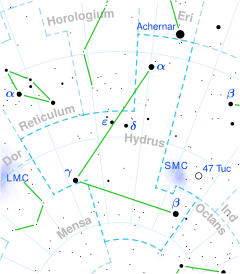astro.wikisort.org - Star
Beta Hydri (β Hyi, β Hydri) is a star in the southern circumpolar constellation of Hydrus. (Note that Hydrus is not the same as Hydra.) With an apparent visual magnitude of 2.8,[2] this is the brightest star in the constellation. Based upon parallax measurements the distance to this star is about 24.33 light-years (7.46 parsecs).[1]
 | |
| Observation data Epoch J2000 Equinox J2000 | |
|---|---|
| Constellation | Hydrus |
| Right ascension | 00h 25m 45.07036s[1] |
| Declination | –77° 15′ 15.2860″[1] |
| Apparent magnitude (V) | 2.80[2] |
| Characteristics | |
| Spectral type | G2 IV[3] |
| U−B color index | +0.11[2] |
| B−V color index | +0.62[2] |
| Astrometry | |
| Radial velocity (Rv) | +22.4[4] km/s |
| Proper motion (μ) | RA: +2,219.54[1] mas/yr Dec.: +324.09[1] mas/yr |
| Parallax (π) | 134.07 ± 0.11 mas[1] |
| Distance | 24.33 ± 0.02 ly (7.459 ± 0.006 pc) |
| Absolute magnitude (MV) | 3.45 ± 0.01[5] |
| Details | |
| Mass | 1.08 ± 0.03[3] M☉ |
| Radius | 1.809 ± 0.015[3] R☉ |
| Luminosity | 3.494 ± 0.087[3] L☉ |
| Surface gravity (log g) | 4.02 ± 0.04[5] cgs |
| Temperature | 5,872 ± 44[3] K |
| Metallicity [Fe/H] | −0.10 ± 0.07[3] dex |
| Rotational velocity (v sin i) | 6.0[6] km/s |
| Age | 6.40 ± 0.56[3] Gyr |
| Other designations | |
| Database references | |
| SIMBAD | data |

This star has about 104% of the mass of the Sun and 181% of the Sun's radius, with more than three times the Sun's luminosity.[3] The spectrum of this star matches a stellar classification of G2 IV, with the luminosity class of 'IV' indicating this is a subgiant star. As such, it is a slightly more evolved star than the Sun, with the supply of hydrogen at its core becoming exhausted. It is one of the oldest stars in the solar neighborhood. This star bears some resemblance to what the Sun might look like in the far distant future, making it an object of interest to astronomers.[3]
Planetary system
In 2002 Endl et al. inferred the possible presence of an unseen companion orbiting Beta Hydri as hinted by radial velocity linear trend with a periodicity exceeding 20 years. A substellar object such as a planet with a minimum mass of 4 Jupiter masses and orbital separation of roughly 8 AU could explain the observed trend.[7] If confirmed, it would be a true Jupiter-analogue, though 4 times more massive. So far no planetary/substellar object has been certainly detected.
These results were not confirmed in CES and HARPS measurements published on the arXiv in 2012. Instead the long-term radial velocity variations may be caused by the star's magnetic cycle.[8]
See also
References
- van Leeuwen, F. (November 2007), "Validation of the new Hipparcos reduction", Astronomy and Astrophysics, 474 (2): 653–664, arXiv:0708.1752, Bibcode:2007A&A...474..653V, doi:10.1051/0004-6361:20078357, S2CID 18759600
- Johnson, H. L.; et al. (1966), "UBVRIJKL photometry of the bright stars", Communications of the Lunar and Planetary Laboratory, 4 (99): 99, Bibcode:1966CoLPL...4...99J
- Brandão, I. M.; et al. (March 2011), "Asteroseismic modelling of the solar-type subgiant star β Hydri", Astronomy & Astrophysics, 527: A37, arXiv:1012.3872, Bibcode:2011A&A...527A..37B, doi:10.1051/0004-6361/201015370, S2CID 37441284
- Nordström, B.; et al. (May 2004), "The Geneva-Copenhagen survey of the Solar neighbourhood. Ages, metallicities, and kinematic properties of ˜14 000 F and G dwarfs", Astronomy and Astrophysics, 418: 989–1019, arXiv:astro-ph/0405198, Bibcode:2004A&A...418..989N, doi:10.1051/0004-6361:20035959, S2CID 11027621
- da Silva, L.; et al. (November 2006), "Basic physical parameters of a selected sample of evolved stars", Astronomy and Astrophysics, 458 (2): 609–623, arXiv:astro-ph/0608160, Bibcode:2006A&A...458..609D, doi:10.1051/0004-6361:20065105, S2CID 9341088
- Pizzolato, N.; Maggio, A.; Sciortino, S. (September 2000), "Evolution of X-ray activity of 1-3 Msun late-type stars in early post-main-sequence phases", Astronomy and Astrophysics, 361: 614–628, Bibcode:2000A&A...361..614P
- Endl; et al. (2002). "The planet search program at the ESO Coudé Echelle spectrometer. III. The complete Long Camera survey results". Astronomy and Astrophysics. 392 (2): 671–690. arXiv:astro-ph/0207512. Bibcode:2002A&A...392..671E. doi:10.1051/0004-6361:20020937. S2CID 17393347.
- M. Zechmeister; M. Kürster; M. Endl; G. Lo Curto; H. Hartman; H. Nilsson; T. Henning; A. P. Hatzes; W. D. Cochran (2012). "The planet search programme at the ESO CES and HARPS. IV. The search for Jupiter analogues around solar-like stars". Astronomy & Astrophysics. 552: A78. arXiv:1211.7263. Bibcode:2013A&A...552A..78Z. doi:10.1051/0004-6361/201116551. S2CID 53694238.
External links
- "Beta Hydri". SolStation. Retrieved November 3, 2005.
- "Beta Hydri". Dr. Jim Kaler. Archived from the original on December 10, 2005. Retrieved March 15, 2005.
- Stellar Activity - Beta Hydri
На других языках
[de] Beta Hydri
Beta Hydri ist ein Stern, der sich von der Erde aus betrachtet in der Nähe des Himmelssüdpols (Sternbild Kleine Wasserschlange oder auch Hydrus) befindet. Beta Hydri ist 6,4 Milliarden Jahre alt und 24,38 Lichtjahre von der Erde entfernt. Der Stern bläht sich gerade zu einem Roten Riesen auf, und es gibt in seinem Sternsystem Hinweise auf das Vorhandensein eines Planeten.- [en] Beta Hydri
[es] Beta Hydri
Beta Hydri (β Hyi)[1] es la estrella más brillante en la constelación de Hydrus con magnitud aparente +2,80. Es la estrella brillante más cercana al polo sur celeste, ya que Polaris Australis (σ Octantis), la estrella polar del hemisferio sur, apenas brilla con magnitud 5,42. En el pasado, hacia el año 150 a. C., Beta Hydri estuvo situada a menos de dos grados del polo. Se encuentra a 24,4 años luz de distancia del sistema solar.[2][ru] Бета Южной Гидры
Бета Южной Гидры (β Южной Гидры, лат. Beta Hydri) — звезда в созвездии Южной Гидры. Находится на расстоянии около 24,4 световых лет от Солнца. Звезда принадлежит движущейся группе звёзд ζ Геркулеса[3].Другой контент может иметь иную лицензию. Перед использованием материалов сайта WikiSort.org внимательно изучите правила лицензирования конкретных элементов наполнения сайта.
WikiSort.org - проект по пересортировке и дополнению контента Википедии